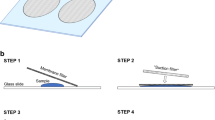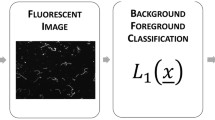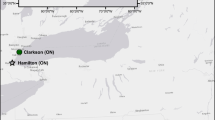Abstract
Determining the viability of protists and small microzooplankton has long been a focus of studies in marine biology and ecology. It is especially relevant in the issue of shipborne invasive species, and impending international guidelines and various national regulations on the allowable concentrations of organisms in discharged ballast water have spurred the growth of an industry that develops and manufactures ballast water management systems. The success of management systems and ability of ships to meet ballast water discharge standards is determined by the number of viable organisms in treated water. Here, we propose combining two vital, fluorescent stains (fluorescein diacetate [FDA] and 5-chloromethylfluorescein diacetate [CMFDA]) with direct microscopic observation to enumerate viable organisms ≥10 and <50 μm in minimum dimension (nominally protists). This approach was validated in four locations in the United States to determine the efficacy of the stains. Although the accuracy of the stains varied by geographic location and the taxonomic composition of the planktonic assemblage, combining fluorescent stains is a robust, powerful tool that can be optimized for the species present at each location. While this method was developed for analyzing viable organisms in treated ballast water, it may also be used or adapted for any field of research that examines a broad taxonomic range of autotrophic and heterotrophic plankton.



Similar content being viewed by others
References
Anderson D (1997) Diversity of harmful algal blooms in coastal waters. Limnol Oceanogr 42:1009–1022
Araújo CV, Diz FR, Moreno-Garrido I, Lubián LM, Blasco J (2008) Effects of cold-dark storage on growth of Cylindrotheca closterium and its sensitivity to copper. Chemosphere 72:1366–1372
Bralewska J, Witek Z (1995) Heterotrophic dinoflagellates in the ecosystem of the Gulf of Gdansk. Mar Ecol Prog Ser 117:241–248
Brussaard CP, Marie D, Thyrhaug R, Bratbak G (2001) Flow cytometric analysis of phytoplankton viability following viral infection. Aq Micro Ecol 26:157–166
Carlton JT (1985) Transoceanic and interoceanic dispersal of coastal marine organisms: the biology of ballast water. Oceanogr Mar Biol Ann Rev 23:313–371
Carlton JT, Geller JB (1993) Ecological roulette: the global transport of nonindigenous marine organisms. Science 261:78–82
Carpenter EJ, Chang J, Shapiro LP (1991) Green and blue fluorescing dinoflagellates in Bahamian waters. Mar Biol 108:145–149
Dorsey J, Yentsch CM, Mayo S, McKenna C (1989) Rapid analytical technique for the assessment of cell metabolic activity in marine microalgae. Cytometry 10:622–628
Dressel DM, Heinle DR, Grote MC (1972) Vital staining to sort dead and live copepods. Chesapeake Sci 13:156–159
Elbrächter M (1994) Green autofluorescence–a new taxonomic feature for living dinoflagellate cysts and vegetative cells. Rev Palaeobotany Palynology 84:101–105
Gallagher JC (1984) Patterns of cell viability in the diatom, Skeletonema costatum, in batch culture and in natural populations. Esutaries Coasts 7:98–101
Garvey M, Moriceau B, Passow U (2007) Applicability of the FDA assay to determine the viability of marine phytoplankton under different environmental conditions. Mar Ecol Prog Ser 352:17–26
Godhe A, Cusack C, Pedersen J, Andersen P, Anderson DM, Bresnan E et al (2007) Intercalibration of classical and molecular techniques for identification of Alexandrium fundyense (Dinophyceae) and estimation of cell densities. Harmful Algae 6:56–72
Herwig R, Cordell J, Perrins J, Dinnel P, Gensemer R, Stubblefield W, Ruiz G, Kopp J, House M, Cooper W (2006) Ozone treatment of ballast water on the oil tanker S/T Tonsina: chemistry, biology and toxicity. Mar Ecol Prog Ser 324:37–55
Hunter BL, Laws EA (1981) ATP and chlorophyll a as estimators of phytoplankton carbon biomass. Limn Ocean 26:944–956
International Maritime Organization (2004) Convention BWM/CONF/36 Adopted 13 February 2004; “International Convention for the Control and Management of Ships’ Ballast Water and Sediments”
International Maritime Organization (2005) G8 Resolution MEPC 125(53) Adopted 22 July 2005; “Guidelines for approval of Ballast water management systems (G8)”
Jochem FJ (1999) Dark urvival strategies in marine phytoplankton assessed by cytometric measurement of metabolic activity with fluorescein diacetate. Mar Biol 135:721–728
Kobiyama A, Tanaka S, Kaneko Y, Lim P, Ogata T (2010) Temperature tolerance and expression of heat shock protein 70 in the toxic dinoflagellate Alexandrium tamarense (Dinophyceae). Harmful Algae 9:180–185
Lage OM, Sansonetty F, O’Connor JE, Parente AM (2001) Flow cytometric analysis of chronic and acute toxicity of copper(II) on the marine dinoflagellate Amphidinium carterae. Cytometry 44:226–235
Laval-Peuto M, Rassoulzadegan F (1988) Autofluorescence of marine planktonic Oligotrichina and other ciliates. Hydrobiologia 159:99–110
Lawrence JE, Brussaard CP, Suttle CA (2006) Virus-specific responses of Heterosigma akashiwo to infection. Appl Environ Microbiol 72:7829–7834
Li AS, Stoecker DK, Coats DW, Adam EJ (1996) Ingestion of fluorescently labeled and phycoerythrin-containing prey by mixotrophic dinoflagellates. Aq Micr Ecol 10:139–147
Munawar M, Munawar IF (1987) Phytoplankton bioassays for evaluating toxicity of in situ sediment contaminants. Hydrobiologia 149:87–105
Murphy AM, Cowles TJ (1997) Effects of darkness on multi-excitation in vivo fluorescence and survival in a marine diatom. Limn Ocean 42:1444–1453
Oemcke DJ, van Leeuwen JH (2005) Ozonation of the marine dinoflagellate alga Amphidinium sp.-implications for ballast water disinfection. Water Res 39:5119–5125
Onji M, Sawabe T, Ezura Y (2000) An evaluation of viable staining dyes suitable for marine phytoplankton. Bull Fac Fish Hokkaido Univ 51:153–157
Poot M, Javanagh TJ, Kang HC, Haugland RP, Rabinovitch PS (1991) Flow cytometric analysis of cell cycle-dependent changes in cell thiol level by combining a new laser dye with Hoechst 33342. Cytometry 12:184–187
Reavie ED, Cangelosi AA, Allinger LE (2010) Assessing ballast water treatments: evaluation of viability methods for ambient freshwater microplankton assemblages. J Great Lakes Res 36:540–547
Register Federal (2009) Standards for living organisms in ships’ Ballast water discharged in US waters; draft programmatic environmental impact statement, proposed rule and notice, 74 FR 44631–44672 (28 August 2009). National Archives and Records Administration, Washington, DC
Savin M, Martin J, LeGresley M, Giewat M, Rooney-Varga J (2004) Plankton diversity in the Bay of Fundy as measured by morphological and molecular methods. Micr Ecol 48:51–65
Seepersad B, Ramnath K, Dyal S (2004) The use of aniline blue for the determination of dead phytoplankton, zooplankton and meroplankton in LC50 testings after 96 hours: a re-evaluation of the US environmental protection agency methodology. J Energy Resour Technol 126:215–218
Stumpf R, Culver M, Tester P, Tomlinson M, Kirkpatrick G, Pederson B, Truby E, Ransibrahmanakul V, Soracco M (2003) Monitoring Karenia brevis blooms in the Gulf of Mexico using satellite ocean color imagery and other data. Harmful Algae 2:147–160
Tang YZ, Dobbs FC (2007) Green autofluorescence in dinoflagellates, diatoms, and other microalgae and its implications for vital staining and morphological studies. Appl Environ Microbiol 73:2306–2313
Tester PA, Steidinger KA (1997) Gymnodinium breve red tide blooms: initiation, transport, and consequences of surface circulation. Limn Ocean 42:1039–1051
Throndsen J (1978) The dilution culture method. In: Sournia A (ed) Phytoplankton manual. Unesco, Paris, pp 218–224
Tjallingii F (2001) Global market analysis released. Ballast Water News 6:6–8
Veldhuis M, Kraay G, Timmermans K (2001) Cell death in phytoplankton: correlation between changes in membrane permeability, photosynthetic activity, pigmentation and growth. Eur J Phycol 36:167–177
Waite T, Kazumi J, Lane P, Farmer L, Smith S, Smith S, Hitchcock G, Capo T (2003) Removal of natural populations of marine plankton by a large-scale ballast water treatment system. Mar Ecol Prog Ser 258:51–63
Williams R, Griffiths F, Vanderwal E, Kelly J (1988) Cargo vessel ballast water as a vector for the transport of non-indigenous marine species. Estuarine Coastal Shelf Sci 26:409–420
Wright D, Dawson R, Orano-Dawson C (2007) Shipboard trials of menadione as a ballast water treatment. Mar Tech 44:68–76
Yentsch C, Menzel D (1963) A method for the determination of phytoplankton chlorophyll and phaeophytin by fluorescence. Deep Sea Res 10:221–231
Acknowledgments
This research was supported by the United States Coast Guard (contract #HSCG23-09-X-MMS028) and does not represent official USCG policy. Many thanks to Mr. Scott Riley, Ms. Stephanie Robbins-Wamsley, and Dr. Matthew First at the Naval Research Laboratory in Key West, Florida and to Dr. Richard Everett for providing feedback that greatly improved this manuscript. Additional thanks to Dr. Mario Tamburri, Mr. Timothy Mullady, Mr. George Smith, and Ms. Janet Barnes from the Maritime Environmental Resource Center; Dr. Andrea Copping, Dr. Dana Woodruff, and Mr. William Pratt from the Pacific Northwest National Laboratory; and Dr. Michael Sieracki and Dr. Nicole Poulton from Bigelow Laboratory for Ocean Sciences for their generous assistance during this project.
Author information
Authors and Affiliations
Corresponding author
Additional information
Communicated by U.-G. Berninger.
Rights and permissions
About this article
Cite this article
Steinberg, M.K., Lemieux, E.J. & Drake, L.A. Determining the viability of marine protists using a combination of vital, fluorescent stains. Mar Biol 158, 1431–1437 (2011). https://doi.org/10.1007/s00227-011-1640-8
Received:
Accepted:
Published:
Issue Date:
DOI: https://doi.org/10.1007/s00227-011-1640-8




